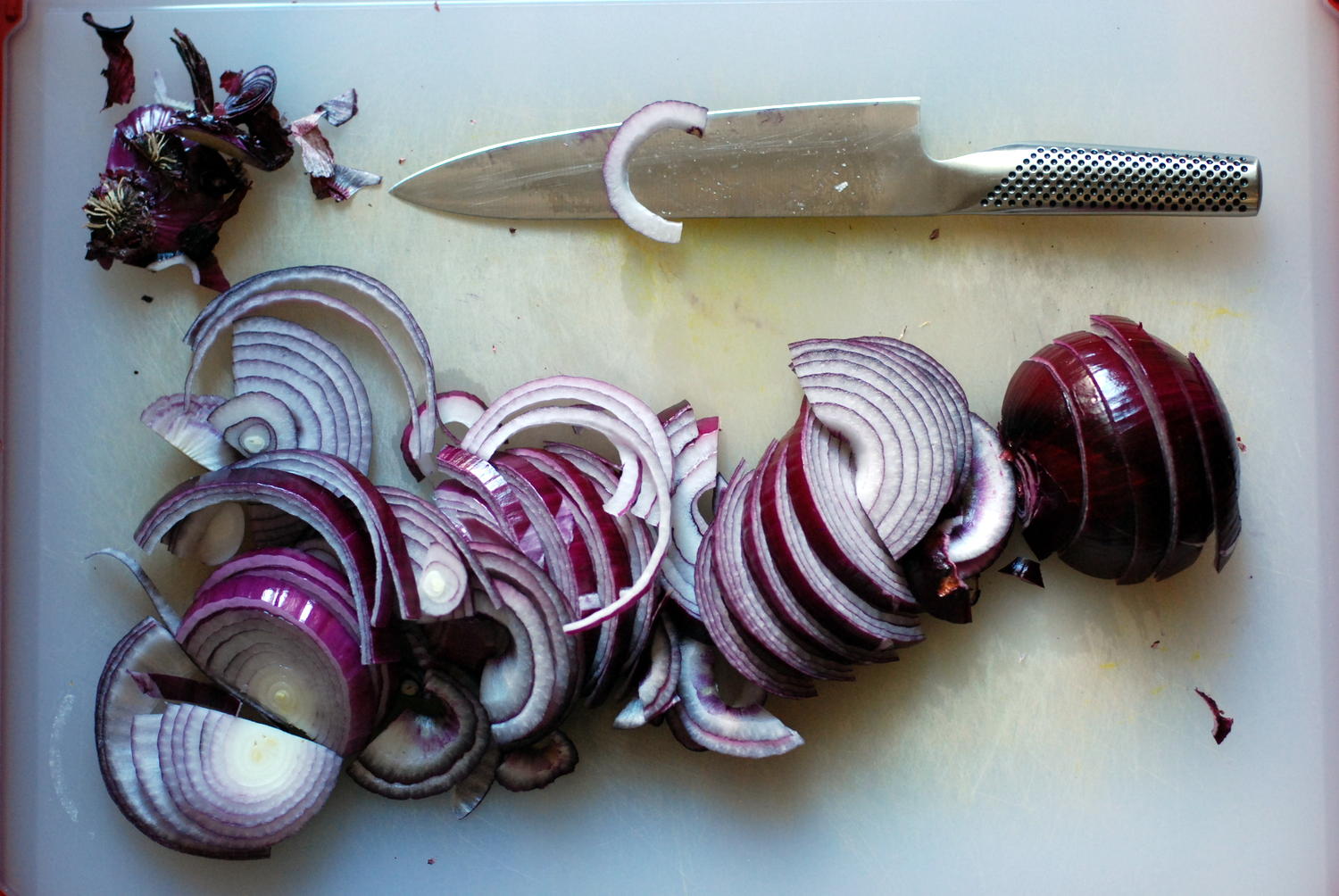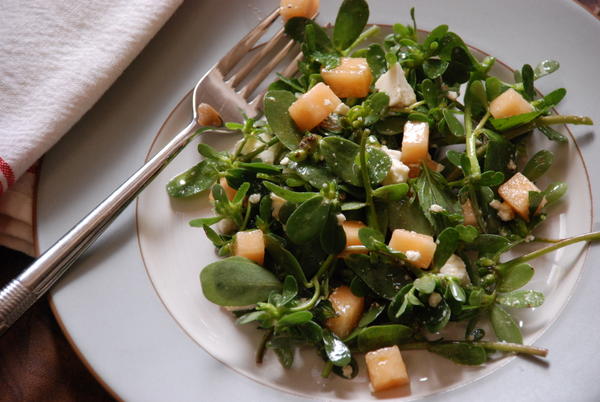I have a (very cynical) theory that for every 10 vegetarian soup recipes out there, 9 of them had authors who sneaked in some chicken stock when no one was looking. I often read these recipes incredulously: you're telling me your meatless soup is deep and complex, and yet it contains no miso, no tomato paste, no porcini mushrooms, no smoked anchovies - no umami whatsoever. Heck, it doesn't even have much in the way of spices. This all seems mostly impossible.
But as I'm not coming to find, there are magical exceptions to this rule. There are owners of a certain restaurant in Brooklyn by the name of Franny's, which I have love-love-loved for a very long time, who make pretty much everything turn to gold. They are experts at pasta and pizza; masters of crostini and of fritti, those fried bites that start a meal. Well, no surprise: it turns out, they're pros at soup, too.
Making a vegetarian soup taste complex and flavorful absolutely requires attention to detail and process; this soup has steps. But, as usual, I did find a couple of shortcuts that'll make this soup use fewer pots and take less time. That said, as written, this probably isn't an ideal choice for a make-and-eat weeknight supper situation. I made a double recipe last weekend, and it lasted us much of the week. Fortunately, this is a soup that improves over time. I also suspect that it'd freeze beautifully, and I'm making a third batch this, the whole of which I'll be freezing for some very theoretical time down the road when time is more of the essence.
Speaking of said time: lots of you have emailed and commented to check in on preggo and bebe. Thank you so, so much. It's the home stretch around here. The babe is in position and ready to go. We've managed to not find out the sex (though this morning's appointment nearly spoiled that - be careful!), and I'm really glad we kept it under wraps; I think it's changed the nature of our anticipation. I thought this stage would be full of wondering and theorizing about what the kid will be like; instead, since that's a total mystery, I've been thinking a lot more about how we'll be as parents. I'm happy not to know more yet; I'm happy to be patient. (I'm also happy to be enjoying a not-at-all small number of peaceful restaurant meals with the lady and with friends; if only I could log them for later.)
The other good news about this phase, at least for my meat-loving wife, is that I've been clearing out the freezer of space-hoggers like spare ribs. In honor of our anniversary, I stovetop-smoked them for about an hour, then let them melt away in a low oven . The whole process was way easier than it sounds. Tutorials here and here, recipe inspiration here, if you're interested. We served them with some very good BBQ baked beans, which I'll tell you about one of these days.
Thinking more about those ribs, I'm happy to have the dregs of my last batch of this soup in the fridge. It'll make a healthy, filling supper.
Good to counteract those apple cider doughnuts I made this weekend, which I'll tell you about later this week. Till then -
Franny's Kale Chickpea SoupAdapted from Franny's: Simple Seasonal Italian Serves 8
On my shortcuts: I skipped the cheesecloth sachet, of course. Instead, I diced the onion small enough that it disintegrated into the soup; I cut the carrot and celery just in half, for easy removal; and the rosemary sprig was easy enough to find and remove. You're also supposed to put 3 garlic cloves in the sachet, but since garlic is such a prominent flavor in the soup anyway, I didn't see the harm in leaving them in there. I'm pretty sure 2 of the 3 found their way into the blender with the portion that got pureed, and I ended up with one of them in my bowl, all smooth and melty, which was delightful. I also sauteed the rest of the garlic in a pan big enough to accommodate the kale, saving one pan in the process. I'm sure you're wondering whether you can make this with canned chickpeas, and while I'm sure you can, I'm also sure the cooking time helps marry the flavors and textures of this soup. Still, I know time is of the essence. If you try it with canned chickpeas, will you report back?
One more note: this soup is pretty perfect as is, but I did just want to note that it works well with greens other than kale. I haven't tried it with collards and probably wouldn't start there, since they can taste a bit chalky after a long liquidy cook. That said, beet greens, in particular, are fantastic in this soup. So if you have a small bunch of kale and a big pile of greens from those beets, don't hesitate to make this.
And one tiny other thing: 1 cup of olive oil. A lot, yes, but not the 1 1/2 cups originally called for, and also not really that much, at 2 tablespoons per serving. Disagree? Think about the fact that most cookie recipes call for 2 sticks butter. That's a cup right there. I've already cut the amount of olive oil by 1/3 - don't skimp further. If anything, be more generous if you feel so inclined.
2 cups dried chickpeas
1 carrot, peeled and cut in half
1 celery stalk, cleaned and cut in half
1 onion, halved (or diced, if you don't want to fish it out with the carrot and celery; see note above)
11 garlic cloves, peeled
5 strips lemon peel
1 sprig rosemary
1 tablespoon kosher salt, more to taste
3 1/2 quarts water
1 cup extra-virgin olive oil, divided; more for drizzling
1/4 teaspoon chili flakes
2 big bunches Tuscan kale or beet greens Freshly cracked black pepper Lemon wedges, for serving
Grated Parmigiano-Reggiano cheese, for servingPut the chickpeas in a medium bowl, cover with at least an inch of water, and let soak overnight.
In a large pot, combine carrot, celery, onion, 3 garlic cloves, lemon peel, rosemary, 1/2 cup olive oil, 1 tablespoon salt, and the 3 quarts water. Bring to a boil over high heat, then reduce the heat to medium-low and simmer until the chickpeas are tender, about 1 hour (more if chickpeas are old). Taste at the end of cooking, and add more salt as needed.
Meanwhile, finely chop or (faster!) crush the remaining 8 garlic cloves. Remove the center ribs from the kale and coarsely chop the leaves (you should have about 16 cups, but if not, no stress). Set up your blender and have the blender canister at the ready.
In a large skillet, heat 1/4 cup olive oil over medium heat. Add the garlic and chili flakes and cook until the garlic is fragrant but not golden, about 1 minute. Transfer to the blender canister (it's okay if some is left in the pan). Immediately add 1/3 of the kale, toss to combine, and cook, tossing occasionally, until tender, about 3 minutes. Transfer cooked kale straight into the blender. Add 2 tablespoons of olive oil and another 1/3 of the kale, and cook in a similar manner, transferring to the blender when cooked. Repeat with the last 2 tablespoons olive oil and the last batch of kale.
When the chickpeas are cooked, fish out the carrot, celery, rosemary, and onion if not diced. Then scoop 2 cups of them and their liquid into the blender with the kale, and puree until smooth. Add this puree back to the pot with the rest of the chickpeas, and cook over medium-high heat until hot.
Serve with grated Parmigiano-Reggiano, a drizzle of olive oil, and lemon wedges on the side.

















